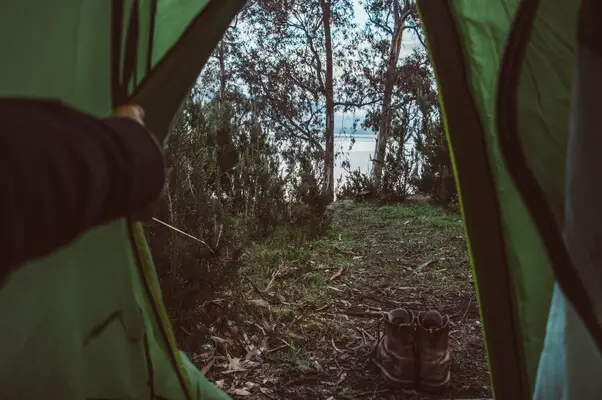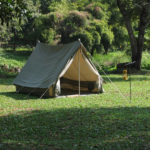When you are camping, having a good shelter is a must. Most experienced hikers or campers invest in quality tents that protect them from any weather conditions.
But some people do not know how to choose a quality tent. They do not know that the tent must have breathable material all over. If you do not have that kind of a tent, I hate to break it to you, but you will be dealing with condensation!
Having condensation in your tent can be very problematic because it can cause problems with your breathing and make all your things wet. You will have to learn how to keep the tent dry, which can be somewhat of a challenge. But do not worry – I have some great methods, tips, and tricks that you can try to stop the condensation in your tent.
So, if you want to learn more about condensation and how to prevent it, you have come to the right place. Stick around for the entirety of this guide, and I do not doubt that you will learn how to deal with the condensation in your tent whenever it appears!
More...

How to Stop Condensation in a Tent? - Proven Methods
There are many situations where a camper can encounter condensation inside their tent. If you happen to be in such a situation, there are a few things that you need to do.
Preventing condensation is crucial because the condensation can cause mold and mildew to grow, which is never a good thing. Before you get to the point of no return with your tent, try my methods to stop the condensation. Let’s get right into the list:
Method 1 – Pitch the tent properly
Pitching the tent in the best way possible is a must. This is because a saggy, badly placed tent can cause much more condensation to appear on the inside. You do not want any condensation inside, so I recommend you do your best to pitch the tent as you should.
When setting the tent, ensure everything is tight and in a good position. If you need to, spend extra time doing this. You can dedicate a few extra minutes to set the rainfly as well, that is, if you have one.
The rainfly is not always obligatory but can often come in handy. It is better to have it than to not have it. If you suspect rain, set the rainfly from the very beginning. Otherwise, keep it on the side and put it up only when you need to.
Method 2 – Choose a good location
The location where you place the tent is as important as the tent setup. You have to be careful not to put your tent on a piece of land that is wet. That can cause moisture to get on the tent fabric and make its way into the tent. So, the ground where you set the tent should always be dry.
Another thing to consider is not to set the tent near water, especially not stagnant water. That kind of water can not only cause humid air inside the tent, but it can also cause some diseases. There are disease-spreading insects that live near those waters, so staying close to them is not smart for several reasons.
Your preferred location should be away from water and direct sunlight. You can stay in the shadow of a larger tree, rock, or somewhere where rain cannot get to you. Once you decide on your location, make sure that you set the tent correctly.
Method 3 – Use the wind to your advantage
Even when scouting for a location, you can try to detect where the wind is coming from. If there is a nice breeze, you can set the tent in that location and let the wind do the ventilation for you. As long as you have constant ventilation, you will have no condensation inside your tent.
After setting the tent up, leave the open vents so the breeze can move through them. Still, you should not sleep in this breeze because it can cause a cold. Perhaps you can leave one vent open and close the rest of them until morning.

How Do I Stop Condensation in My Tent at Night?
Nights spent in a tent should be enjoyable. This is the time when you get some rest after a tough day. It is not the time when you need to worry about condensation and what it can do to you or your tent.
To better your camping experience, I want to share a few tips to stop condensation in your tent during the night. Let’s see what it is that you can do:
Keep wet gear out of the tent
When you have warm air inside your tent, you are bound to get some condensation. Still, you do not want to add to it by keeping wet gear in the tent. It will only cause condensation build-up and can even lead to moisture development.
If the weather is humid and your clothes are too, consider leaving them outside the tent. That includes your wet shoes, jacket, and other wet clothing you might have. As for the food, you can also leave it out to keep it cool during the night.
If you suspect there might be wild animals around the campsite, try to create a stuff sack for the food you will attach to a tree branch or something similar. That way, the animals will not be able to get to it. Keep it a bit further away from the campsite too, when attaching it!
Keep the space ventilated
I recommend keeping the tent ventilated as much as possible to prevent tent condensation. Leaving it in the breeze can do the trick. If there is a breeze, leave all vents open for as long as possible. That will keep the walls cool and prevent condensation from forming inside your tent.
If the tent's fabric stays cool at all times, there is bound to be less condensation. The same goes for tents made with breathable material. These tents are condensation-free, and that makes them a great investment. So, if you are on the market for a new shelter, think about getting one made from breathable material.
How Do I Stop Condensation on My Tent Roof?
Besides the tent walls and ground, condensation can also strongly affect the tent roof. There is no easy way to prevent this condensation, but there are a few ways to improve the situation. So, let me tell you more about the things you can do to deal with tent roof condensation once and for all:
Get a breathable cap
Suppose your tent is not made from breathable materials. In that case, you should consider replacing some of its parts with that kind of condensation-free material. The breathable cap on the tent roof can be a small investment that makes a huge difference. It will not be causing condensation but helping release moisture from the tent!
For camping trips that take place in warmer temperatures, you can even go without the cap. The open space at the top will allow the tent body to cool down, which will help with condensation. If you find condensation on the wall or anywhere else, try wiping it down and leaving the tent to dry and ventilate.
Throw away the rainfly
Rain flies are great because they help you stay dry even in heavy rain. Some people choose to have the rainfly over their tent even in regular weather because it prevents morning dew from making its way to the tent material. Whereas that much is understandable, the rainfly can cause some condensation inside your tent.
Tent condensation forms when the warm air inside the tent meets the cold tent fabric. To prevent the condensation, you will need to allow constant ventilation. That will be possible if you remove the rainfly and let the tent body breathe. By doing that and leaving the vents open, warm air will not build up inside your tent.
Consider investing in a rainfly that has an easy setup. That way, you will be able to manipulate it as needed. Who knows, that might be the thing that helps you get rid of the condensation once and for all.
Wrap-Up
Tent condensation is never a good thing. Dealing with wet tent walls or wet clothes is a waste of time. It is so much better to prevent condensation in the first place than to deal with it once it comes around. So, I recommend applying the abovementioned methods to protect the tent from condensation.
Do you know any other methods that you would recommend to other campers? Let me know in the comments below if you do or if you decided to give my methods a try. I would love to know your experience and how it all went down. So, do not hesitate to share everything with me.
- Are Merrell Shoes Good? – An Unbiased Review of Merrell Footwear - December 9, 2023
- Where Are Merrell Shoes Made? - December 9, 2023
- Camping in 40-degree Weather: Tips and Tricks - September 25, 2023

![How to Get Burrs Out of Clothes? [Most Effective Ways] How to Get Burrs Out of Clothes? [Most Effective Ways]](https://grandcircletrails.com/wp-content/uploads/2022/06/How-to-Get-Burrs-Out-of-Clothes-150x150.jpg)
![How to Inflate an Air Bed without a Pump? [Most Effective Ways] How to Inflate an Air Bed without a Pump? [Most Effective Ways]](https://grandcircletrails.com/wp-content/uploads/2022/07/How-to-Inflate-an-Air-Bed-without-a-Pump-150x150.jpg)
![How to Dry Tent after Rain? – 2 Proven Methods [Explained] How to Dry Tent after Rain? – 2 Proven Methods [Explained]](https://grandcircletrails.com/wp-content/uploads/2021/08/How-to-Dry-Tent-after-Rain-1-150x150.jpg)

![How to Make Toast While Camping? [Methods You Need To Try] How to Make Toast While Camping? [Methods You Need To Try]](https://grandcircletrails.com/wp-content/uploads/2022/07/How-to-Make-Toast-While-Camping-150x150.jpg)
